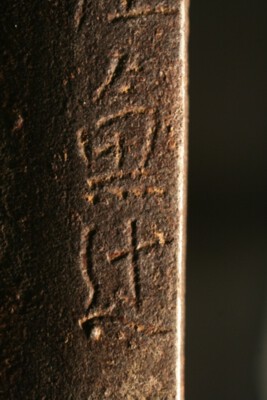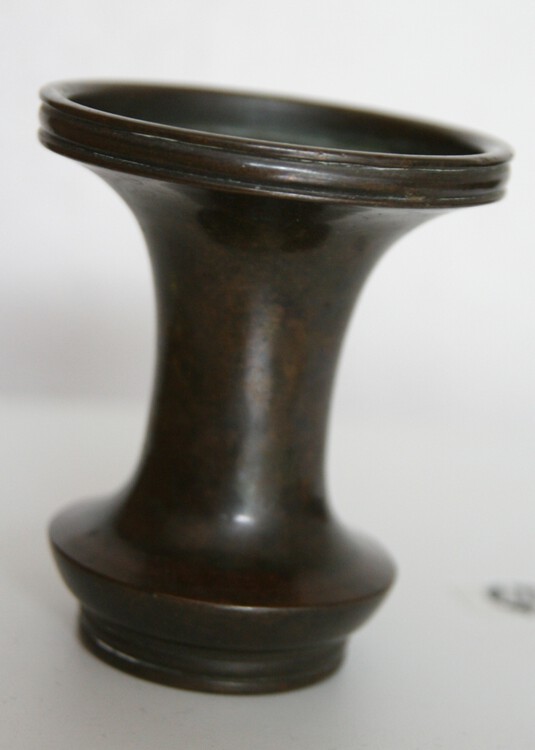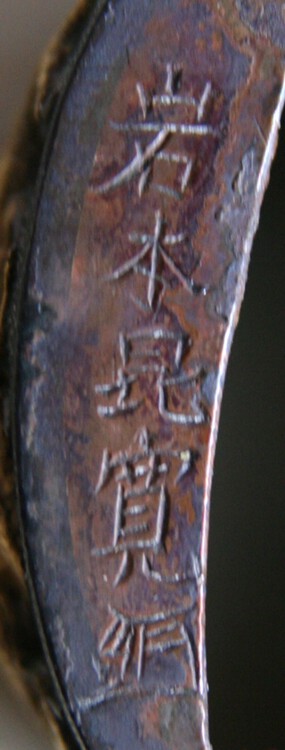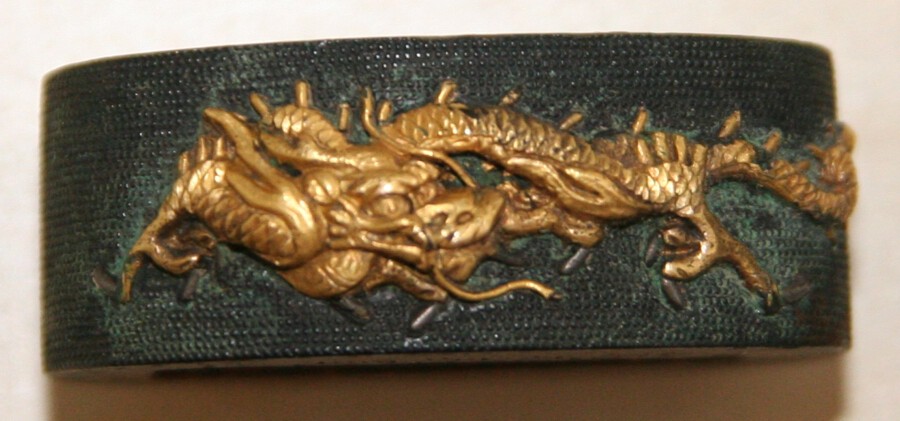
Klop
Members-
Posts
121 -
Joined
-
Last visited
Content Type
Profiles
Forums
Events
Store
Downloads
Gallery
Everything posted by Klop
-
Dear members, A while ago I couldn't resist to buying this remarkable item, a large yari-like blade which was mounted in an original naginata shaft with nice metal fittings. Obviously this is a later marriage as the shaft was not custom made for this nakago. The blade machi to tip is 32 cm, at the widest nearly 7 cm and total length 58 cm. Thickness at the spine around 7 mm. As you might expect this thing is Heavy! At the tip the edge is blunt, about 1 mm thick. sides are thinner but still not razor sharp. Hamon is present in nioi, can't tell if there is hada in it's current condition but I wouldn't be surprised if it's there. Then the inscriptions; on one side above the mekugi ana I see a date. Although the carving seems a bit sloppy/hastily done I think it says "MEIJI SANJU ICHI NEN ICHI GATSU", which should be 1898 first month. Same side below the ana, province and smith: "OWARI JU XX XX TSUKURU" Other side above the ana: well, here I'm lost (almost) completely. Very long shots, 2nd maybe Chi, 3rd Go? I don't know what construction to expect here because province, smith and date are already covered on the other side...I bet it won't be a cutting test I do remember a thread where 2 similar newly polished "yari" were shown, If I recall correctly these were recently made and meant as presentation pieces for a shrine. Unfortunately I can't find this thread anymore. So there are some questions to be dealt with; Are the readings that I do have right? What does the rest say? And, ehhrm (this one is slightly embarrasing), what did I buy? Does the species have a name and how would it be mounted originally (naginata shaft looks fine though, that's not the issue)? It seems to be too well made to be an early tourist piece and the colour and yasuri on nakago seems to correspond with the inscribed date. Any info would be great! Best regards, Eric.
-
Another strange tool or weapon?
Klop replied to estcrh's topic in General Nihonto Related Discussion
Hi, I would think that the loop could be another form of mekugi-ana, maybe a quickfix of broken nakago. It's easier to hammer out the tip of nakago and turn it around than punching a hole, especially if you are alone; one hand to hold piece in pliers, one hand with hammer, one hand with punch in pliers....Assuming this was done in the old days before drillbits (surely looks like that is the case). Another idea is to use this as a throwing arrow /dart , ne-ya. Attach some string/feathers/cloth to the loop for drag and the point will hit the target because drag is in a straight line. A normal mekugi ana halfway nakago used this way would cause unbalance because the force of drag is not in line with the tip. About the bashin-option; weren't these meant to be carried in a (waki)saya instead of a kozuka, mainly in Higo province? I don't think this piece would fit nicely in a kozuka-slot. Blade too thick, backside not flat. Whatever it's purpose, it's a cute piece of point! Greetings, Eric. -
Ian, That's good info. I did know about the new rules in the UK (and I thought Monty Python was absurd...) but not about the bidding-filter on Ebay. I'll keep that in mind when I sell something on ebay next time. As I live in the Netherlands shipping to the UK shouldn't be a problem because it's all EU, no customs check on content? To all; Shipping swords and the like to the Netherlands is not a problem, adults are free to import them, collect them etc, only not carry them openly in public space (" Well officer, I just thought I'd take my naginata for a stroll in the park today, is that so strange?") Firearms is another story but that's not for this forum. Items from outside the EU are subject to import taxes, and then antiques >100 years have a special cheap rate of 6% instead of the normal 19,5% on consumption articles. That's something for the shipping label. But please don't punish all serious and innocent buyers from abroad because some people sabotage auctions. Let potential buyers contact you and check out their feedback, that's one of the good things about ebay. Greetings, Eric.
-
What is this? Lacquered Blade???
Klop replied to SwordGuyJoe's topic in Auctions and Online Sales or Sellers
Hi Joe, I hope you mean this blade -otherwise there's more of them at the same time and that would really freak me out... blade: http://daimyou51eb.web.infoseek.co.jp/K-66/index.htm Auction : http://cgi.ebay.com/SAMURAI-Katana-swor ... 45ee8bb78e if i zoom in on the red closeups i see what looks like a foundation polish or even a window that was abandoned. Don't think that's a good sign, whatever the golden script may say. But I am very curious too so if there's anybody or nobody out there who can translate.... Greetings, Eric. -
Hi Tom, Thanks for your input. The discussion was about the waki, it started with translation assistance and evolved in the question of it being nihonto or modified gunto. Just in front of the hi is one group of sanbonsugi or... well, I see 3 peaks, but that's not really the issue. This part is not in the closeups of the hamon because I opened the window further near the tip where it has a different shape. Since Brian merged the threads I presume you saw the closeups of the wak's nakago with signature. The katana is what I would call sanbonsugi all over but was just for comparison of sizes and curvatures, it's not being discussed. So you are absolutely right, there are no closeups of the katana's hamon. I apologize for any inconvenience or confusion, I just felt that the disucssion about a sword being nihonto or not is a completely different one than having it's inscription translated and should therefor be in it's own section. As far as I'm concerned all questions have been answered, thanks to all! Best regards, Eric.
-
Hi Mark, That's a shame... But the good news; to me it looks solvable. You could do it yourself if you know how to handle tools; take a new flat piece of buffalo horn (for example http://www.namikawa-ltd.co.jp/cgi-bin/i ... te=24&no=1 ) and cut out the hole that goes over the wooden guchi in which the blade enters. That is a delicate job, first step is a jigsaw (manual of course) to cut an undersized hole and than refine it with a set of small files (locksmith files). Frequent fitting ensures the right size. Keep the horn piece oversized in relation to the outside of the saya. When it is glued in place you work this access down to the right level all around ( protect the laquer next to it with tape) with small file, sandpaper up to #1000 or 2000 and polish (dremel miniature buffer is great for this). Take care not to round of the edges, you want the lines of the saya to continue straight to the seppa! When the new horn koiguchi is done maybe the crack on the seem closes to an acceptable level automatically, otherwise some touching up with laquer or paint should do the trick, copying the structure if possible. I myself would not consider relaquering the whole piece or just the upper section, better some minor damage than complete loss of the original coating. Unfortunately I don't know anybody who can do this for you if you can't do it yourself. A remark about the cause and prevention; this damage looks like the blade was pushed in so far that the habaki split the mouth. In other words, the mouth is just a bit too tight to accept the habaki well, if the new situation is just as tight it might happen again. Maybe this has to do with different temperature and moisture, what was a good tight fit in Japan might become a too tight where you are because of shrinking wood. Adjusting the fit slightly might be the answer - by file, not sandpaper because of lost grains vs polish! Good luck, Eric
-
Hello gents, As promised in the translation topic I've opened a window and took some more measurements. The total picture we are looking at in cm's: nagasa 55,5 nakago 16,5 sori 1,8 motohaba 2,9 motokasane 6 mm sakihaba 2,1 sakikasane 4,5 mm The picture with comparison to a (handforged) gunto also shows the outline of the hamon which is quite wild; mountains, near the end of the Hi are a few "3 cedars", then some more mountains with a tobiyaki in the middle section and in the monouchi it straightens out a bit. Closeups show nie. Habaki custommade for this blade, better quality folded brassy sheetmetal cover. Yasurime on the nakago not visible, cutting edge worn down, hamachi virtually gone. Based on this I would say it is safe to conclude "true nihonto, pre-showa". But then it just starts... shinto? or even koto? Does the style of hamon and nakago fit Seki, Mino? I'm looking forward to hearing your thoughts. Best regards, Eric.
-
Hi Grey, Barry, Thanks for your input, I see what you mean and I too think that something might have been there once. I hope I'm not trying to fool myself and I don't want to be stubborn, if you are right you are right, simple as that. But in this case....well, the blade just doesn't have the "feel" of gunto to me. I have owned a few of them -literally just a few- and I think they are quite clumsy. This one seems different. I'm pretty sure it's handforged / water-quenched and the nagasa of 55,5 cm is not a normal gunto size (dangerous remark, now it may become a broken gunto )? Furthermore the short hi on both sides and a perfectly fitting brassplated habaki point me towards true nihonto. If only the hamachi would have been ground down the shape would be awkward, unless the whole edge up to the kissaki was treated this way. I'll take some more measurements and open a window to show hamon and grain, pics of this will follow later. To everyone who is a bit shy ; I welcome all input, even if it's not what you think I would like to hear. Just be frank, by sharing opinions I can learn. I won't be offended by an honest remark. At last to the moderators; maybe you want to close or relocate this thread as the translation of the inscription seems done, at least there appears to be no resistance to the "tsuji" bit... So that's what it says, discussion about it being genuine/gunto/gendaito may belong in the nihonto section? Best regards, Eric.
-
Gentlemen, Thanks for your input so far. I'm in doubt whether this is gimei; are the known kanetsuji important enough to falsify? It doesn't approach the oshigata shown so if it is an attempt to copy it's a lousy one At least the inscription seems old, but that doesn't say much. Is the style and position on the nakago OK? In that case maybe the mei is original but from a not so famous smith... I'll attach a pic of the complete nakago. Best regards, Eric
-
Gentlemen, Could you review and complete my work on this signature? I believe it says "No shu seki ju kane xxx". The last one possibly "Tsuji" but I am not sure about that. The nakago is somewhat glossy because a previous owner used the tipsection of a scabbard as tsuka, fixing the blade with some (artificial) resin. On this "tsuka" they nailed a hanger for paintings so this was definately a wallpiece, I think for the last decades untill I received it. Blade is nagasa 55,5 cm with sori 1,8, although hamachi is just about gone there is still a good portion of hamon left which is quite irregular, also boshi is healthy. Any info about smith (era, rating) and opinions are welcome! Thanks, Eric.
-
Hello all, Same here, received this mail on the 22nd, didn't reply. I haven't been a member for a long time so the email-address must have been harvested recently if this board is where he/they got it. But might as well be a tap on Ebay or something else. Greetings, Eric.
-
Moriyama san, thank you very much! Best regards, Eric.
-
Gentlemen, I recently acquired this yari, seller stated the signature to be SUNPU ANSAÏ JU SADAKUNI (Shizuoka ken). As far as I can tell this translation is correct, and the old province would have been Suruga; wikipedia says; "Sunpu Domain (駿府藩, Sunpu-han?) was a Japanese feudal domain intermittently during the Edo period. It was centered in Suruga Province, in what is now the city of Shizuoka, but at times included Kai and parts of Tōtōmi Provinces. In 1869 the domain was renamed Shizuoka Domain (静岡藩?)." So in this case, would Ansai be the city in which this smith worked, in Sunpu domain? I searched the smith database for sadakuni but I don't find one in this province. Maybe it's not even sadakuni after all? Knowing the smith would also give a clue about age, given the condition of the head and color/yasuri on the nakago my guess is shinto. The first stage of polishing reveiled a nice wavy hamon going all the way round, size of the head is 18 x 2,3 cm. Any info on this smith (and then if the mei is legitimate) would be greatly appreciated. Best regards, Eric.
-
other END, not and
-
Dear Veli (or should I say "deer Veli"?), Nice set of horns! Here's the tantokake I made from a set of small antlers I found on a flea market, combined with a rock from the garden shop. I drilled holes for a wooden peg in the antler base, and holes in the rock (some granite I guess) for the other and of the peg. Hammerdrill and the rock didn't even crack, pfew... If Bambi is missing, I know nothing Kind regards, Eric
-
Moss, A few moths ago I bought an Edo iron fuchi with some floral engraving from them. It cost me about us $ 8,- , on my request shipped SAL without tracking etc to prevent shipping costs being more than the item itself. It arrived sooner than expected, safe and sound. Communication was OK and no surprises. Of course, with this kind of money I dared to take a chance. No experience with swords or other expensive stuff. Kind regards, Eric.
-
Zugabe; I guess that with this rim you could cut towards it until you are stopped by it, or start at the rim with the cutter vertical, belly against the rim. Then use the rim as leverage when pulling the cutter handle backwards. Kind regards, Eric.
-
Hello Gentlemen, I haven't tried it yet, but if I would have to make this kind of delicate yasuri I would use a hand-driven cutter like goldsmiths do. See picture for a few of these, of course the widths and cutting profiles vary endlessly. The mushroom handle lies in the palm of the hand for power, fingertip on the cutter point for control. The handle is flattened on one side to allow a shallow angle. You wouldn't want the cutter to dig itself in... An idea for the jig/rig would be a piece of wood with a nail through it, point upwards. Drill a similar sized hole in the exact middle of the tsuba blank, place it over the nail and then place another thin piece of wood (plastic, metal) with a slot for the cuttingtool over it. There you have the desired central vanishing point and guidance for the chisel. Move the the guide or the tsuba after each cut. See picture (and note the lovely mokume :D ) After all the grooves are made cut out nakago- and other ana's. Btw; I too love the tusba that started this thread! Kind regards, Eric.
-
Moriyama-san, thank you very much! Best regards, Eric.
-
Gentlemen, Not Nihonto but a nice piece of old metal anyway; I bought this single bronze vase of just 9 cm tall about a year ago. Now I've got a signature book and I still cannot find anything My very long shot for the second character is "moto" but that's about it. Even about the spaces I am not sure, but I lean towards 5 characters divided like in the picture with yellow markings (especially no 3 and 4 raise doubt) . Is that correct? Has someone got an idea about this inscription? I guess there used to be a twin vase once to form a set for a family altar, a single vase of this size seems a bit strange to me. But then again, that's just a feeling and not knowledge. All ideas are welcome! Best regards, Eric.
-
Fuchi signature translation assistance please
Klop replied to Klop's topic in Translation Assistance
Reinhard & Ludolf, Thank you very much for the assistance! So I got the 4th character right after all, only I was looking at the hiro and not the kan. And of course having no clue whatsoever that this is an absolute treasure that would suit my Masamune perfectly :lol: To be honest I never even heard of the man, I'm just a novice at swords and fittings are not my main interest. So fortunately I didn't buy it as an original, no harm done on the financial front. Best regards, Eric. -
Dear members, I'm trying to translate a fuchi inscription but I can't crack it alone. Using the book "Japanese art signatures" by James Self and Nobuko Hirose I get : 1: Iwa (character number 451, 8 strokes) 2: Moto (833, 5 strokes) 3: Kon (773, 8 strokes, chinese, no japanse equivalent given) 4: Hiro (404, 14 strokes) 5: X (inscription seems a bit messy, can't count the strokes and i find nothing matching). Can you correct and/or complete this? Even if I've got the "Kon" right I still don't know the meaning of it, explanation would be most welcome. Thanks you, Eric.
-
Address Nomura's polishing stone shop Tokyo?
Klop replied to Klop's topic in General Nihonto Related Discussion
Gentlemen, thank you again! Brian, it took me a good night sleep to realise that you may have meant to visit Namikawa's shop myself instead of orderding by mail as I am used to. If you did, good idea! It turns out that they are located in Tokyo as well so that's perfect. Because my time overthere is limited I won't go searching for the shop that may not even exist anymore. I'll ask Namikawa if they can come up with something by the time I get there (my 3 week journey starts in Fukuoka and covers a nice part of the country via Nagasaki, Matsuyama, Hiroshima and Kyoto). Best regards, Eric. -
Address Nomura's polishing stone shop Tokyo?
Klop replied to Klop's topic in General Nihonto Related Discussion
Thanks Brian, Namikawa is in my favorites-list and I already bought some supplies from them in the past, always a pleasure. So if I can't find Nomura or similar that is a backup plan. Though i'd love to cut the costs for shipping (stones tend to be heavy), customs & taxes by bringing something along as a souvenir within weight and value limits. Best regards, Eric. -
Hello members, I 'm a bit ashamed to admit I just now stumbled across this thread... So with a little delay, here's me: My name is Eric Klop, age 36 and I live in The Netherlands. I've been lurking this site and especially the translation section for about the last year and I learned a lot in that period. And I intend to keep on doing so, as it's not only education but also fun with the humorous conversations going on. I've always liked edged metal -weapons, knives, tools and started collecting with indonesian kerises. Inevitably this evolved into nihonto, with on the side some middle eastern daggers and one indian katar. My curse; I like everything; blades, mountings, spears, inro, netsuke etcetcetc. Luckily this is not an unhealthy addiction :D So far for now, you'll see me some more in the future. Best regards, Eric.























